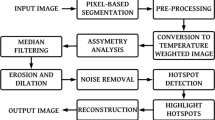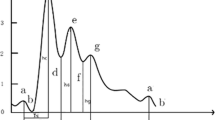Abstract
Diabetes is a disorder of metabolism—the way our bodies use digested food for growth and energy. The most common form of diabetes is Type 2 diabetes. Abnormal plantar pressures are considered to play a major role in the pathologies of neuropathic ulcers in the diabetic foot. The purpose of this study was to examine the plantar pressure distribution in normal, diabetic Type 2 with and without neuropathy subjects. Foot scans were obtained using the F-scan (Tekscan USA) pressure measurement system. Various discrete wavelet coefficients were evaluated from the foot images. These extracted parameters were extracted using the discrete wavelet transform (DWT) and presented to the Gaussian mixture model (GMM) and a four-layer feed forward neural network for classification. We demonstrated a sensitivity of 100% and a specificity of more than 85% for the classifiers.






Similar content being viewed by others
References
Aboderin, I., Kalache, A., Ben-Shlomo, Y., Lynch, J. W., Yajnik, C. S., Kuh, D., and Yach, D., Life course perspective on coronary heart disease: key issues and implications for policy and research. World Health Organization: Geneva, 2002.
Abouaesha, F., van Schie, C. H., Griffths, G. D., Young, R. J., and Boulton, A. J., Plantar tissue thickness is related to peak plantar pressure in the high-risk diabetic foot. Diabetes Care 24(7):1270–1274, 2001.
Albert, S., and Rinoie, C., Effect of custom orthotics on plantar pressure distribution in the pronated diabetic foot. J. Foot Ankle Surg. 33:598–604, 1994.
Gefen, A., Plantar soft tissue loading under the medial metatarsals in the standing diabetic foot. Med. Eng. Phys. 25:491–499, 2003.
Armstrong, D. G., and Lawrence, A. L., Diabetic foot ulcers: prevention, diagnosis and classification. AFP Fam. Pract. Ann. 57(6):1337–1338, 1998.
Caselli, A., Pham, H., Giurini, J. M., Armstrong, D. G., and Veves, A., The forefoot-to-rearfoot plantar pressure ratio is increased in severe diabetic neuropathy and can predict foot ulceration. Diabetes Care 25(6):1066–1071, 2002.
Cavanagh, P. R., Sims, D. S., and Sanders, Jr., L. J., Body mass is a poor predictor of peak plantar pressure in diabetic men. Diabetes Care 14:750–755, 1991.
Cavanagh, P., and Ulbrecht, J., Biomechanics of the foot in diabetes mellitus. 5th ed. Year Book Inc., 1993.
Cornwall, M. W., and McPoil, T. G., Effect of foot orthotics on the initiation of plantar surface loading. Foot 7:148–152, 1997.
DeLeo, J. M., Receiver Operating Characteristic Laboratory (ROCLAB): software for developing decision strategies that account for uncertainty. In: Proceedings of the Second International Symposium on Uncertainty Modeling and Analysis (pp. 318–325). Los Alamitos, CA: IEEE Computer Society Press, 1993.
Downey, T. J., Meyer, D. J., Price, R. K., and Spitznagel, E. L., Using the receiver operating characteristic to asses the performance of neural classifiers. International Joint Conference on Neural Networks 5:3642–3646, 1999.
Abouaesha, F., Carine, H., van Schie, M., David, G., Armstrong, D. P. M., Andrew, J., and Boulton, M., Plantar soft-tissue thickness predicts high peak plantar pressure in the diabetic foot. J. Am. Podiatr. Med. Assoc. 94(1):39–42, 2004.
Frykberg, R. G., Lavery, L. A., Pham, H., Harvey, C., Harkless, L., and Veves, A., Role of neuropathy and high foot pressures in diabetic foot ulceration. Diabetes Care 21(10):1714–1719, 1998.
Grimm, A., Kastenbauer, T., Sauseng, S., Sokol, G., and Irsigler, K., Progression and distribution of plantar pressure in Type 2 diabetic patients. Diabet. Nutr. Metab. 17(2):108–113, 2004.
Jacob, T. V., Mothiram P., Radhakrishnan, K., Narayanamurthy, S., and Parivalavan, V. B., The role of skin hardness, thickness, and sensory loss on standing foot power in the development of plantar ulcers in patients with diabetes mellitus—a preliminary study. Low. Extrem. Wounds 2(3):132–139, 2003.
Orlin, M. N., and McPoil, T. G., Plantar pressure assessment. Phys. Ther. 80:399–409, 2000.
Pataky Z., Assal, J.-P., Conne, P., Vuagnat, H., and Golay, A., Plantar pressure distribution in Type 2 diabetic patients without peripheral neuropathy and peripheral vascular disease. Diabet. Med. 22(6):762–767, 2005.
Prabhu, K. G., Patil, K. M., Srinivasan, S., A new method of analysis of standing foot pressure images for detection of plantar ulcers in early-stage diabetic neuropathy. Front. Med. Biol. Eng. 11(1):31–43, 2001.
Rahman, M. A., Aziz, Z., Acharya, U. R., Tan P. H., Natarajan, K., Ng, E. Y. K, Law, C., Subramaniam, T., and Shuen, W. Y., Analysis of plantar pressure in diabetic Type 2 subjects with and without neuropathy. Innov. Technol. Biol. Med. (ITBM-RBM), France 27(2):46–55, 2006.
Reaven, G. M., Role of insulin resistance in human disease. Diabetes 37:1595–1607, 1988.
Redmond, A., Lumb, P. S., and Landorf, K., Effect of cast and noncast foot orthoses. J. Am. Podiatr. Med. Assoc. 90:441–449, 2000.
Reed, L., and Bennett, P. J., Changes in foot function with the use of Root and Blake orthoses. J. Am. Podiatr. Med. Assoc. 90:184–193, 2000.
Sauseng, S., Kastenbauer, T., Sokol, G., and Irsigler, K., Estimation of risk for plantar foot ulceration in diabetic patients with neuropathy. Diabet. Nutr. Metab. 12(3):189–193, 1999.
Mallat, S., A wavelet tour of signal processing. Academic: New York, 1999.
Tekscan, USA. http://www.tekscan.com/medical/case_fscan.html (January 2005).
Treece, K. A., Macfarlane, R. M., Pound, N., Game, F. L., and Jeffcoate, W. J., Validation of a system of foot ulcer classification in diabetes mellitus. Diabet. Med. 21:987–991, 2004.
Veves, A., Murray, H. J., Young, M. J., and Boulton, A. J. M., The risk of foot ulceration in diabetic patients with high foot pressure—a prospective study. Diabetologia 35:660–663, 1992.
Weinstein, S., Fifty years of somatosensory research: from the Semmes Weinstein monofilaments to the Weistein enhanced sensory test. J. Hand Ther. 6(1):11–22, 1993.
Yegnanarayana, B., Artificial neural networks. Prentice-Hall of India: New Delhi, 1999.
Seifter, G. E., England, S., Carbohydrate metabolism in diabetes mellitus: Theory and practice 4th ed (Edited by Rifkin H and Porte D Jr), Elsevier Publishing Co. Inc., New York, 1990, pp. 1–40.
The American Orthopaedic Foot and Ankle Society, The Diabetic Foot. http://www.aofas.org/diabetic.html (24 March 2006).
Charanya, G., Patil, K. M., Narayanamurthy, V. B., Parivalavan, R., Visnanathan, K., Effect of foot sole hardness, thickness and footwear on foot pressure distribution parameters in diabetic neuropathy, Proc. Instn. Mech. Engrs., Journal of Engineering in Medicine, Part H 218:431–443, 2004.
Bhatia, M. M., Patil, K. M., New on-line parameters for analysis of dynamic foot pressures in neuropathic feet of Hansens disease subjects. J. Rehabil. Res. Dev. 36:264–272, 1999.
Masson, E. A., Hay, E. M., Stockley, I., Veves, A., Bretts, R. P., and Boulton, A. J., Abnormal foot pressures alone may not cause ulceration. Diabet. Med. 6:264–272, 1989.
Author information
Authors and Affiliations
Corresponding author
Rights and permissions
About this article
Cite this article
Acharya U, R., Tan, P.H., Subramaniam, T. et al. Automated Identification of Diabetic Type 2 Subjects with and without Neuropathy Using Wavelet Transform on Pedobarograph. J Med Syst 32, 21–29 (2008). https://doi.org/10.1007/s10916-007-9103-y
Received:
Accepted:
Published:
Issue Date:
DOI: https://doi.org/10.1007/s10916-007-9103-y




